Add a little spice to your nonlethal defense plan.
Not every threat requires a deadly response. Nevertheless, we might need something to help “even the odds,” so to speak, and give us some degree of control over the situation. Rather than going hands-on, if we can keep our distance, so much the better.
Pepper spray has been one of the go-to options in this regard for quite some time. It works well in many applications, especially if you opt for the streaming delivery mode rather than a fog or mist. However, you might sometimes need an even more-direct approach.
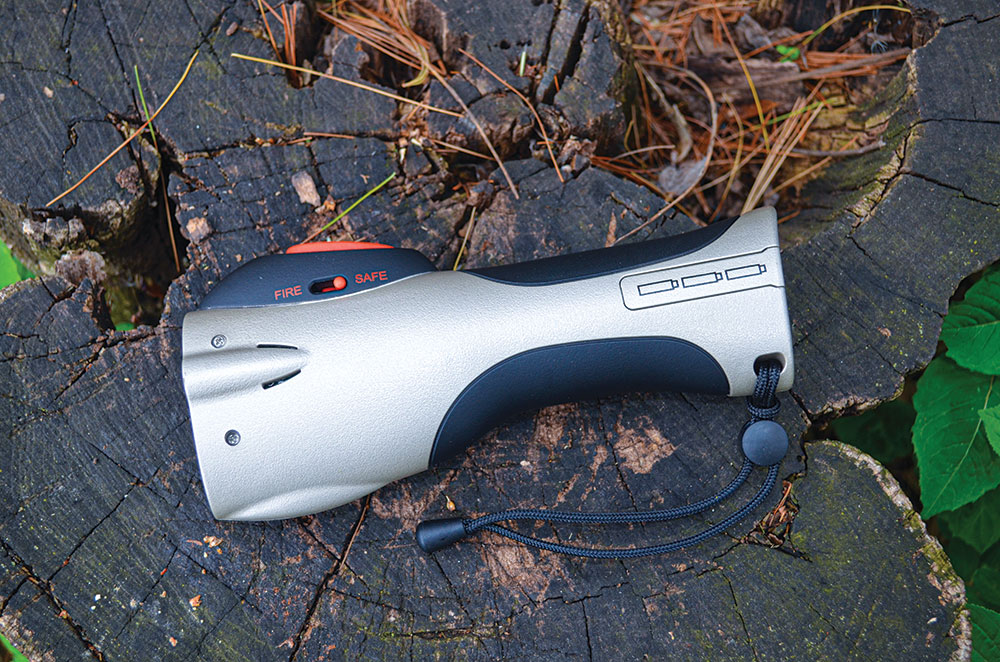
Thus, the PepperBall was born!
The Pepper Ball is a small sphere filled with PAVA pepper powder. When launched, it strikes an attacker with enough force to shatter the plastic coating, releasing the powder in a cloud that will hopefully envelop the person.
The company that manufactures PepperBall (PBLifeLite.com) sent me two devices to test and evaluate: the MOBILE Kit and the COMPACT launcher.
The MOBILE Kit
The larger of the two products is the MOBILE Kit. It comes with a launcher, a dozen practice rounds, six PepperBall rounds and three CO2 cartridges. The launcher can hold up to three rounds and fires them one at a time.
The package advertises that this device will launch projectiles upward of 40 feet. It also states that it will provide a 12-foot “pepper irritant cloud,” in addition to forceful-impact stopping power.
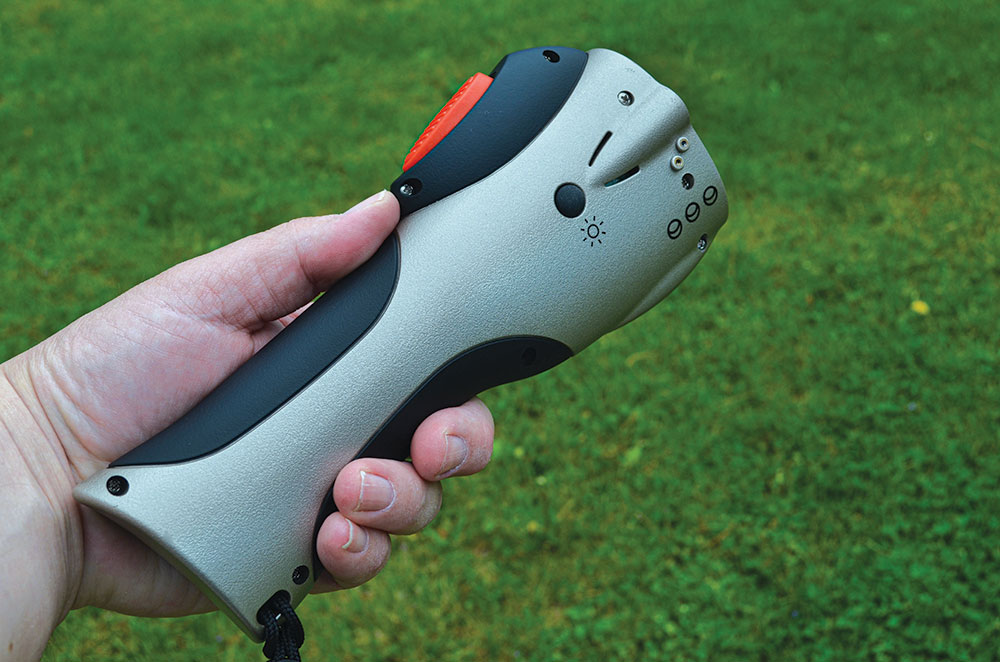
Unboxing
My first impression was that this is a fairly large piece of equipment. It weighs 1.4 pounds and runs 9 inches from end to end. The shape reminds me of a flashlight—albeit one with sort of a spotlight-shaped head. To be honest, I felt it was bulky and a bit cumbersome the first time I picked it up.
The projectiles, themselves, are .68 caliber, or about the size of marbles. The purple ones are inert and made of hard plastic. While they can be used for practice as you perfect your aim, I found they would pack quite a punch if used against someone. The red ones are live PepperBalls. Both the purple and red projectiles are packaged six to a tube, and the tubes are prominently labeled.
The launcher is equipped with two LED lights—one on each side of the launcher’s face—providing a stated 350 lumens. It also has a red laser aiming system. The light and the laser are both powered by three AAA batteries, which are included. There’s a small, white tab that prevents the batteries from draining; it’s removed before the device can be used. To replace the batteries, it’s a simple matter of sliding the battery door off to access them. However, batteries aren’t needed to actually fire the weapon, because that operation is gas-powered.
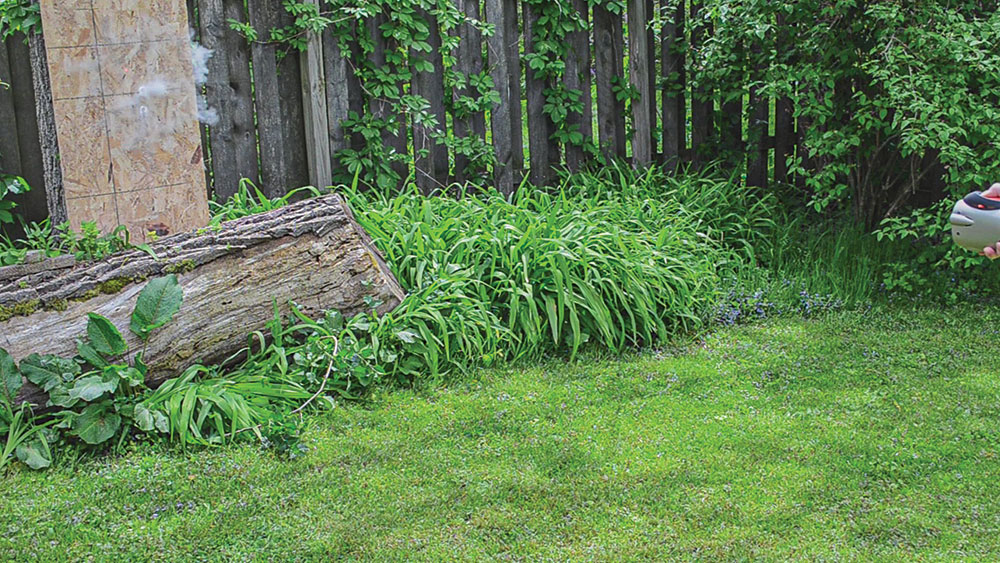
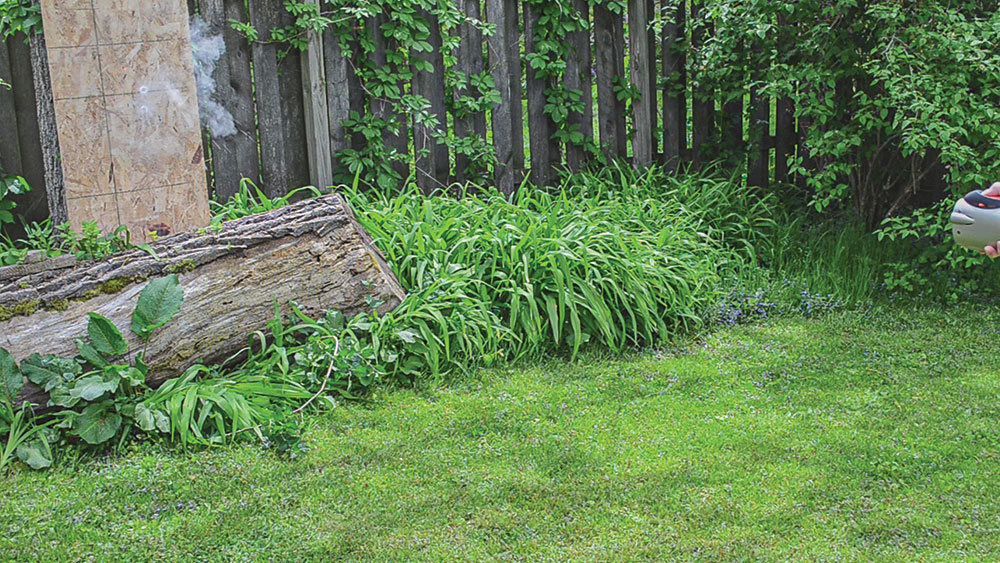
Testing
Loading the MOBILE launcher is a two-step process, involving the projectiles, as well as a CO2 cartridge.
Before doing anything, ensure the launcher is set to “safe.” There are three openings on the front of the launcher. The launch chamber is in the middle. Above is where the CO2 cartridge is inserted. Unscrew the cap and slide the cartridge in, with the narrow tip going in first, and then replace the cap by screwing it down tightly. To load the projectiles, unscrew the bottom cap and roll them in. Then, screw the cap on. It’s all very simple and easy.
“The [MOBILE’s] launcher is equipped with two LED lights—one on each side of the launcher’s face—providing a STAted 350 lumens. It also has a red laser aiming system.”
A good friend of mine has been a law enforcement officer for more than 30 years. He was interested in helping me test these products, so we loaded up and headed over to a private range. (For documentation purposes, it was about 70 degrees [F], partly sunny, and there was a slight, but fairly steady, breeze of about 10 mph.)
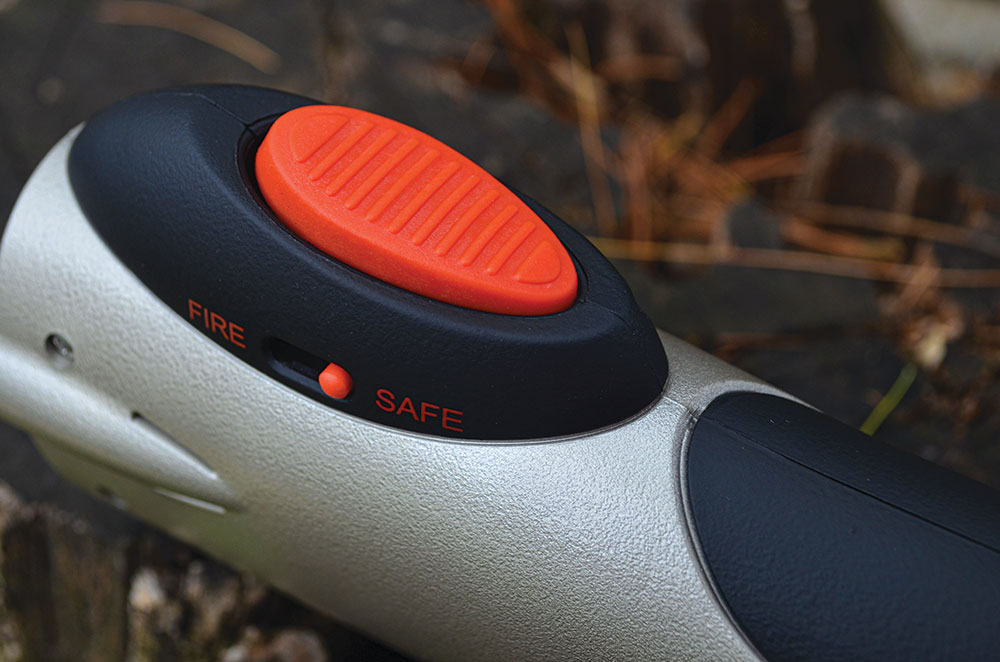
We reviewed the instructions one more time and then carefully loaded the MOBILE launcher with three inert practice projectiles. Moving the safety from “safe” to “fire” activates the laser automatically. I took aim on a plastic barrel and depressed the trigger button.
At first, it seemed as though nothing was going to happen; but I discovered you have to press fairly hard to fire the weapon. When it fired, it did so with authority, and it emitted a loud snap! as the round was shot out.
Neither of us could track that first shot, because it was sort of a surprise when it fired. My friend took the next two rounds, and we began zeroing-in the weapon. Because it was daytime, we had a hard time seeing the laser dot. We also discovered that you need to tilt the weapon down just slightly in order to aim it properly—likely due to the barrel being about 2 inches from the top of the weapon. While the range certainly exceeded 40 feet, we had trouble with accuracy at that distance.
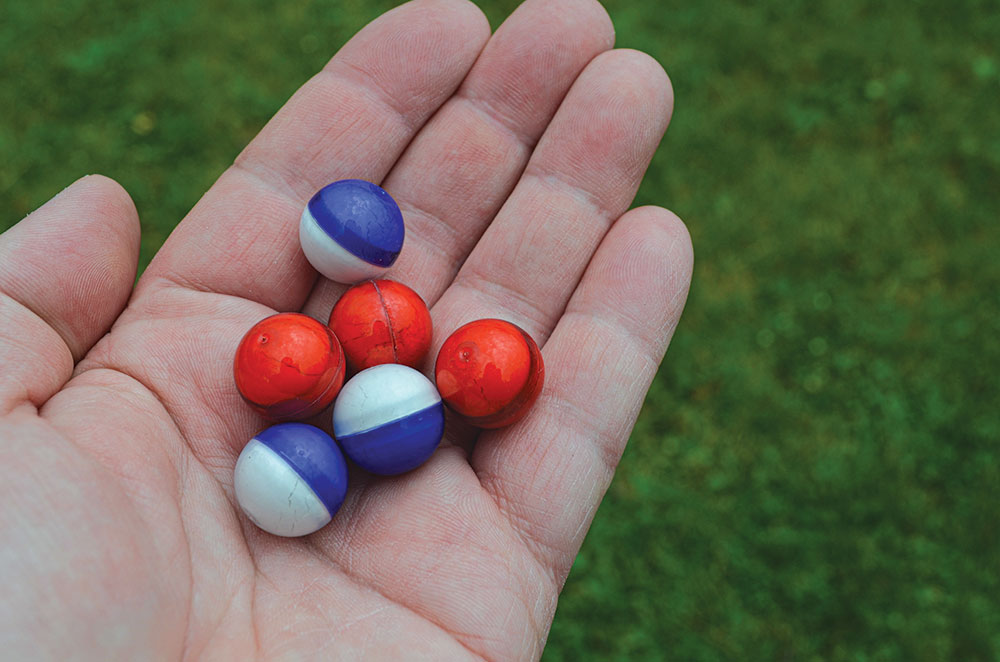
After loading the MOBILE with three rounds of the red-colored PepperBall projectiles, we moved to a closer target. We shot from a distance of about 15 feet. At that range, an impact with this weapon is guaranteed to get the target’s attention. I wouldn’t say it has true knockdown power, but it’ll likely raise a substantial welt. We figured it would probably give them enough pause for you to take whatever further action you felt was necessary.
“Rather than going hands-on, if we can keep our distance, so much the better.”
Upon impact, there was, indeed, a cloud of pepper dust that arose. However, it was far smaller than 12 feet. I’d say, maybe half that. With the mild breeze, it dispersed rapidly. We fired off several more rounds, with similar results. Along the way, we discovered one CO2 cartridge is good for nine shots.
The next day, I asked my wife to give it a try in the backyard. It was a bit warmer—around 80 degrees (F), with more humidity in the air. We set up a board against a tree at the back of our property, and she let loose with a few shots. She said she found the safety switch stiff but manageable. Other than that, she had no real complaints.
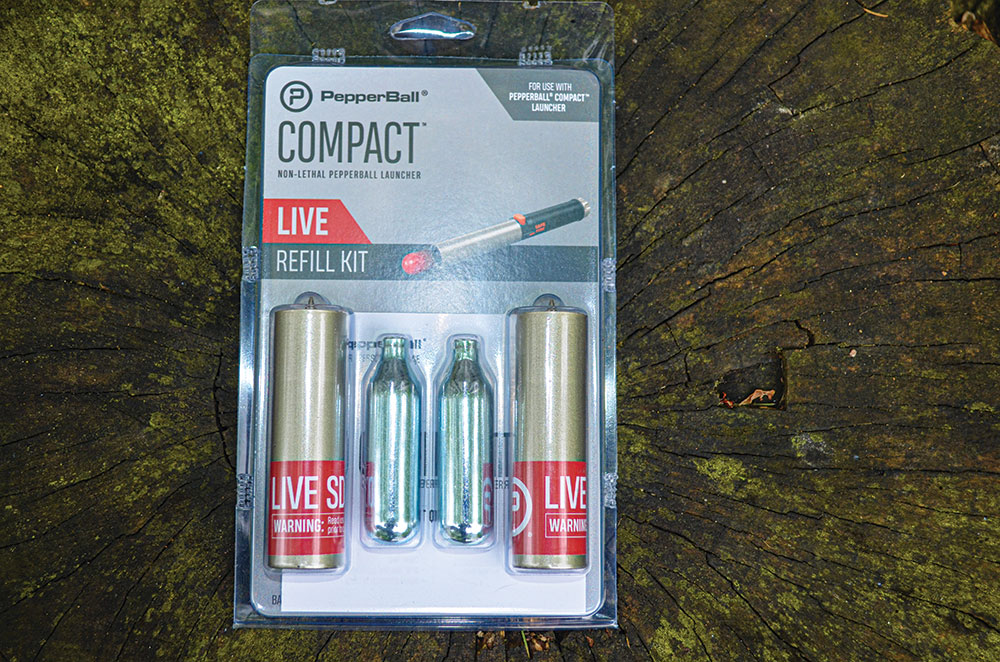
Pros and Cons
In the “pros” column, the MOBILE has quite a bit of power and is certain to cause more than a little pain to anyone who’s on the receiving end of it. It also has some nice features, such as the laser and the flashlight.
However, in the “cons” column, this weapon is entirely too big and bulky to comfortably carry on your person as any sort of EDC (everyday carry) item. As you might expect, there’s a substantial learning curve for aiming the device accurately. In addition, I’m not digging that the weapon is loaded from the same end it shoots from. I’d much rather the projectiles and CO2 cartridges were loaded from the back end.
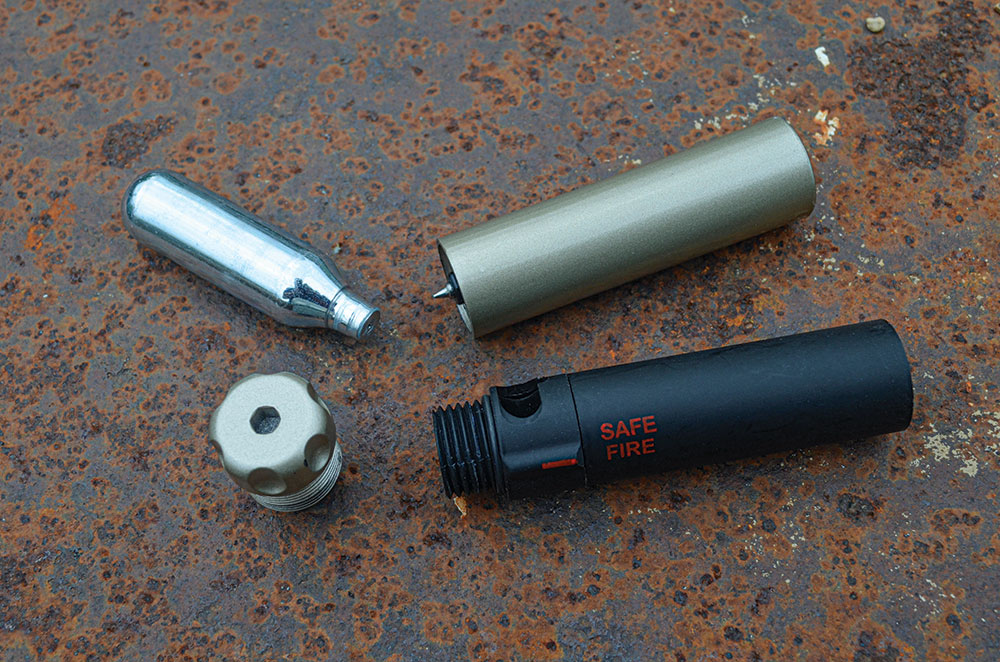
The COMPACT
Moving over to the smaller of the two products, the COMPACT is a single-shot, reloadable launcher. It’s about 7 inches long and under an inch in diameter. It arrives in the package preloaded and ready to fire.
According to the package, it has a range of 30 feet. It fires the same PepperBall rounds as the MOBILE, although they’re configured a little differently.
“ … the MOBILE has quite a bit of power and is certain to cause more than a little pain to anyone who’s on the receiving end of it.“
Unboxing
This consisted of unpackaging, not unboxing, because the COMPACT comes in a clear, plastic clamshell. As noted, it comes preloaded with a single projectile, as well as a nitrogen cartridge. It’s slim and fairly lightweight—about 2.5 ounces. The COMPACT is plastic, with the handle portion having a slight bit of texturing for traction. While the COMPACT is sold preloaded with a PepperBall, you can purchase a refill kit that has one inert projectile, as well as one PepperBall.
Operation is pretty simple: Move the selector from “safe” to “fire,” and then depress the orange button to fire the round.
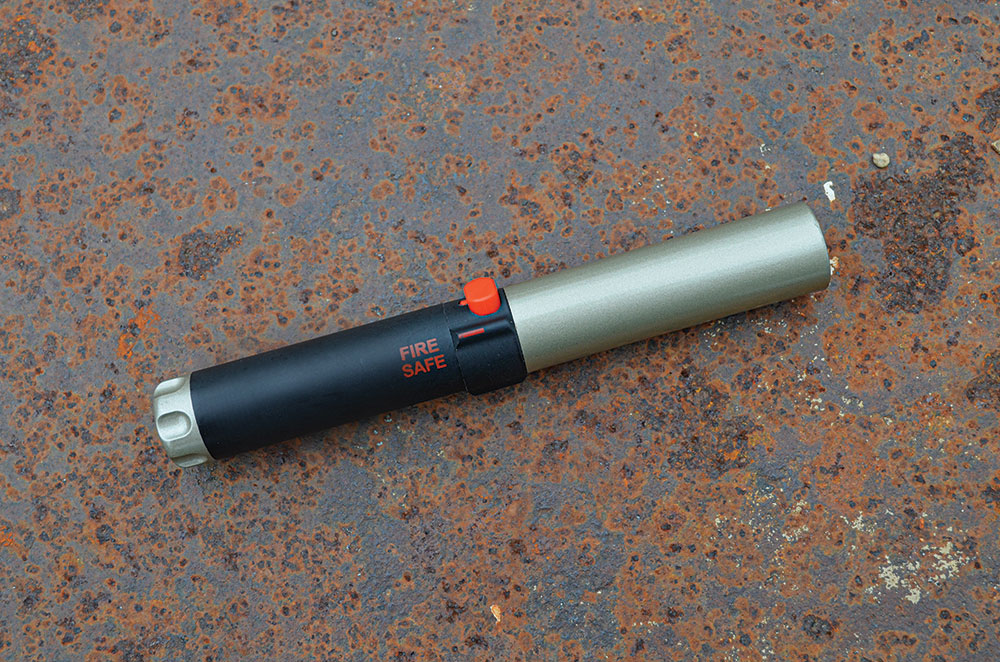
Testing
We opted to stick with the shorter-range target to better see how the COMPACT compared to the MOBILE.
Aiming the weapon was instinctive, not unlike aiming a flashlight. Despite the COMPACT’s smaller size, I’d estimate the projectile impacted the target even harder than we’d seen with the MOBILE. The dispersal of the PepperBall, itself, was the same as the others had been—which was expected.
In addition to the loud snap! we’d now grown accustomed to hearing when firing one of these weapons, there was also a loud hiss as the gas remaining in the cartridge vented out. When the company states that this is a single-use weapon, it isn’t kidding: Once it’s fired, I don’t think it would even make a very good blunt-force weapon, given its light weight.
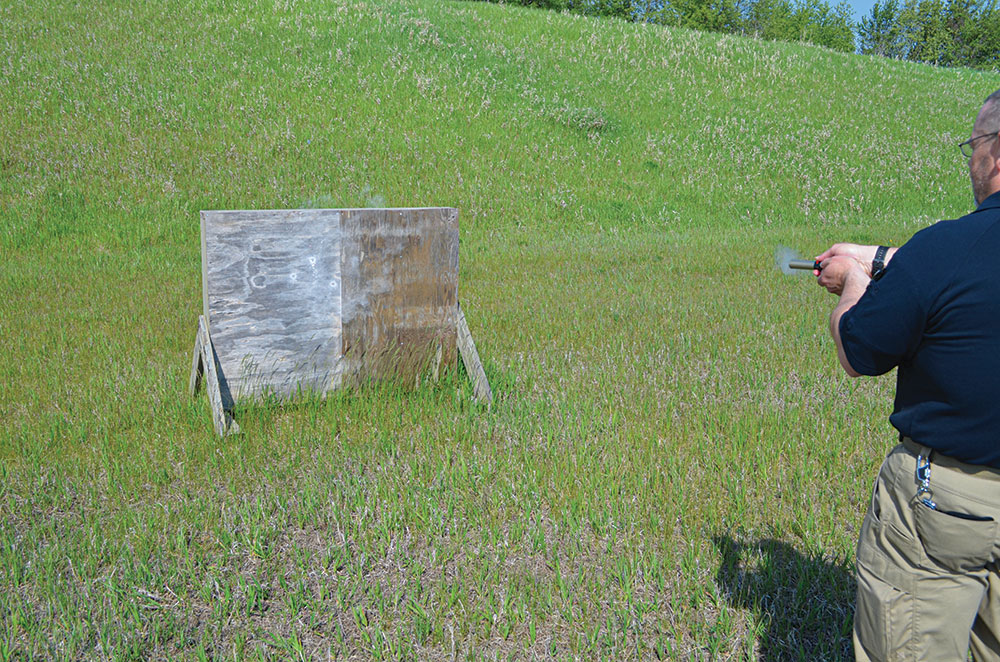
Something to consider with the COMPACT is that because of its design, you can’t practice with it unless you purchase a refill kit or two. Thankfully, it’s a pretty simple operation to just point and shoot.
To reload, you have to purchase the COMPACT Refill Kit. This comes with two preloaded barrels and two gas cartridges. Remove the old barrel and screw on the new one; also remove the old gas cartridge and replace it with the new one. It should go without saying that this process takes a little time, as well as fine motor skills, to complete. In other words: Don’t count on being able to do this quickly enough to get off a second shot at an assailant before they’re on top of you.
Pros and Cons
In the “pros” column: I liked the small size of the COMPACT. It’s easily concealed in a pocket and light enough to not feel like a boat anchor. It’s very powerful for its size, giving a strong impression that it could really cause injury to someone who gets hit—in addition to whatever deterrent the PepperBall provides. The COMPACT is easy to fire, and while I wouldn’t say it’s capable of pinpoint accuracy, that’s not a requirement of a weapon such as this.
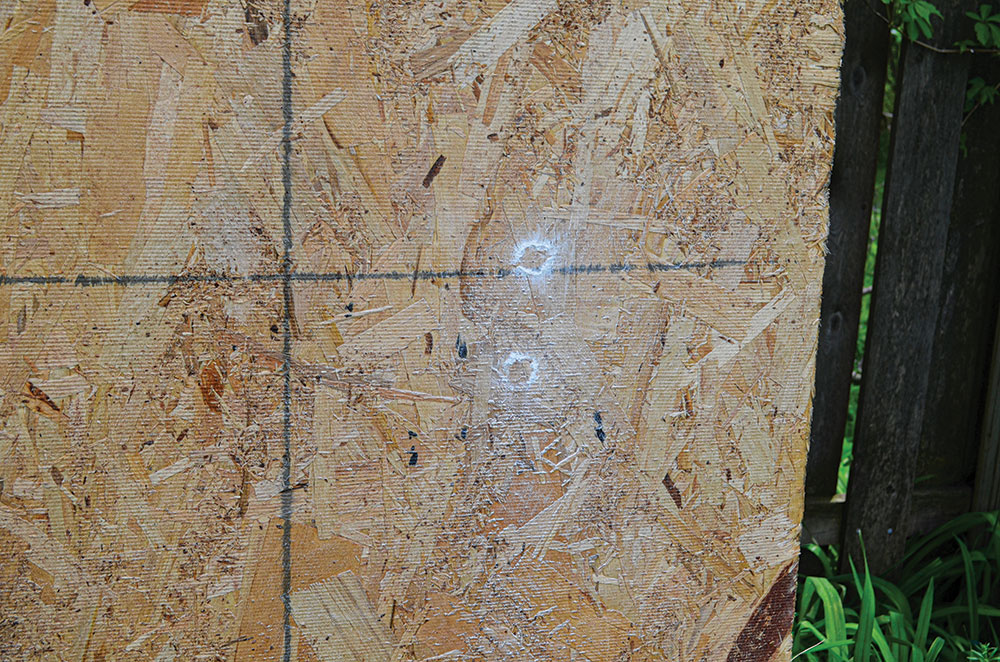
In the “cons” column: I don’t like the single-use aspect, especially considering how the user must replace both the loaded barrel and the gas cartridge. While the weapon is easy to fire, I think that accuracy at any true distance is going to decline, especially in a high-stress situation. At 10 to 15 feet, it’ll probably be fine, but beyond that, the likelihood of a miss increases substantially. If that happens, the user’s going to be no better off than they were before firing the weapon … unless the PepperBall impacts a wall or other surface close enough to the assailant to have some effect on them.
“Not every threat requires a deadly response. Nevertheless, we might still need something to help ‘even the odds,’ so to speak, and give us some degree of control over the situation.”
Overall Impressions
My friend and I discussed the weapons at length while we were at the range, as well as afterward.
The MOBILE would be a decent option for home use, such as keeping it in a drawer in the bedroom in case of a late-night home invasion. Its integral flashlight gives you an illumination tool and a weapon, all in one.
It might also be useful for those working as security personnel at a large venue—whether they use the PepperBall projectiles or just the hard-plastic, inert ones.
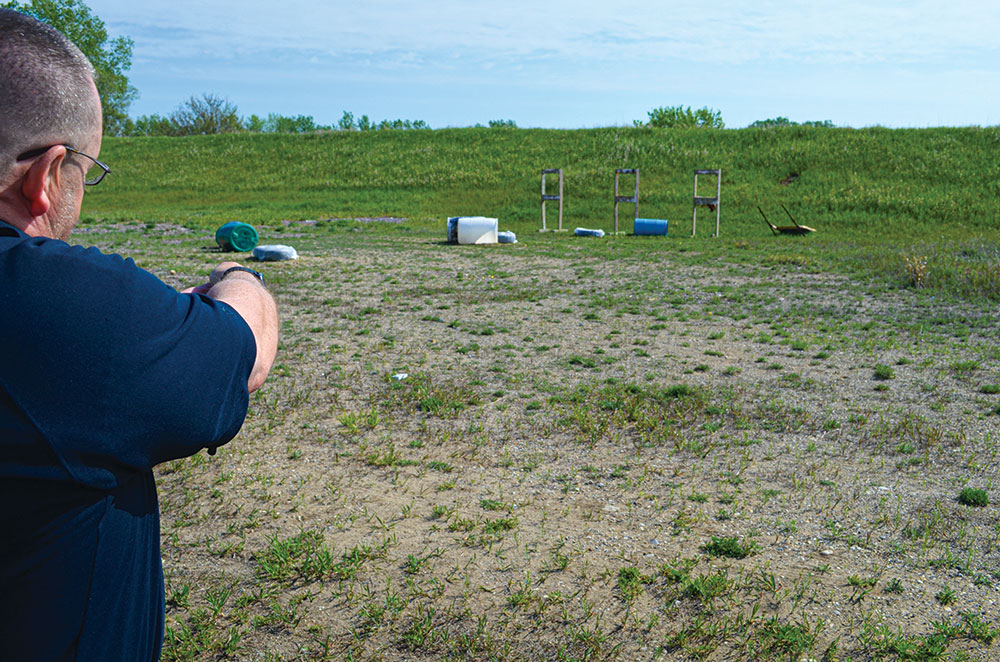
However, the MOBILE is too bulky and unwieldy for the average person to just carry around with them.
As for the COMPACT, given its ease of concealment, this might work well for someone who wants to carry something when they’re out walking the dog or engaging in another activity for which they don’t want to be weighed down. Even so, the COMPACT’s usefulness is severely limited by the single-shot capacity.
That said, my friend and I are both considering picking up a couple more, along with refill kits, to give to family members.
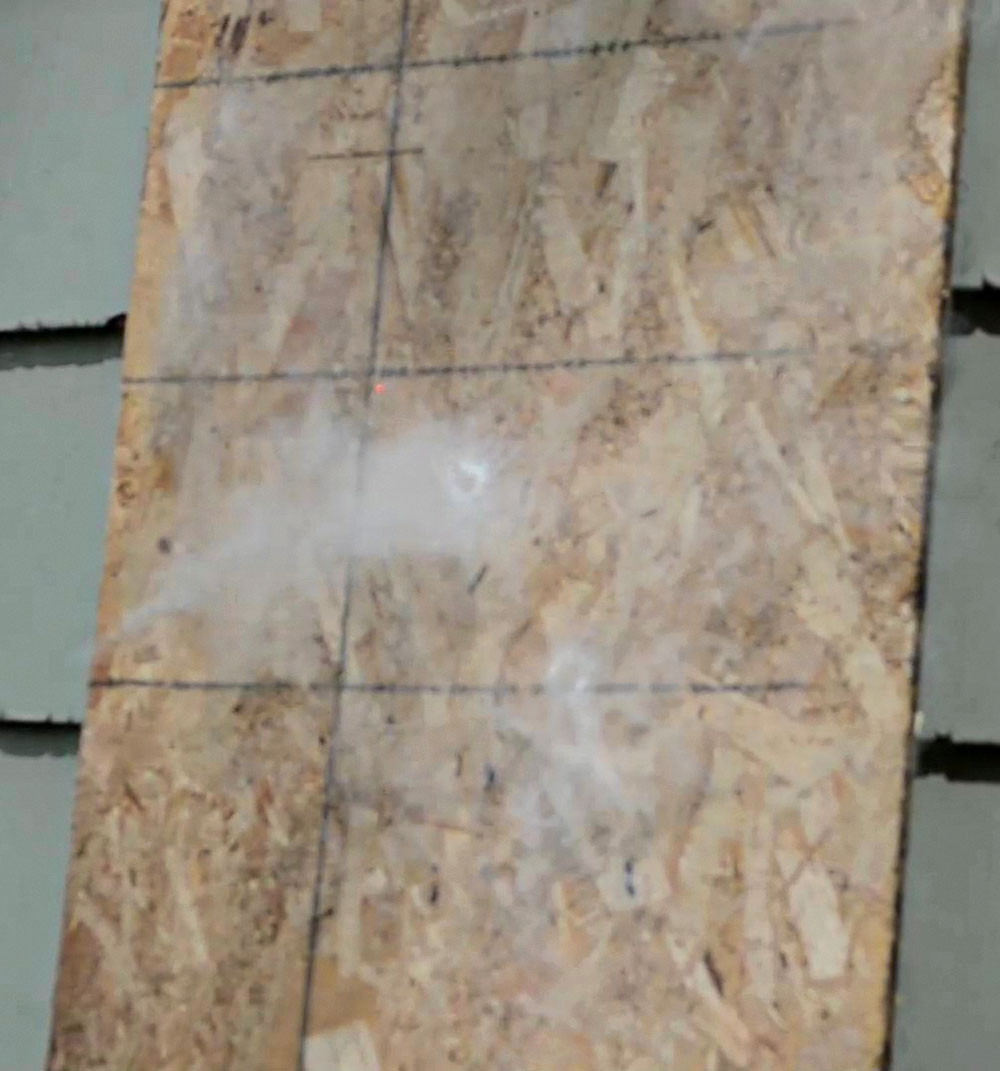
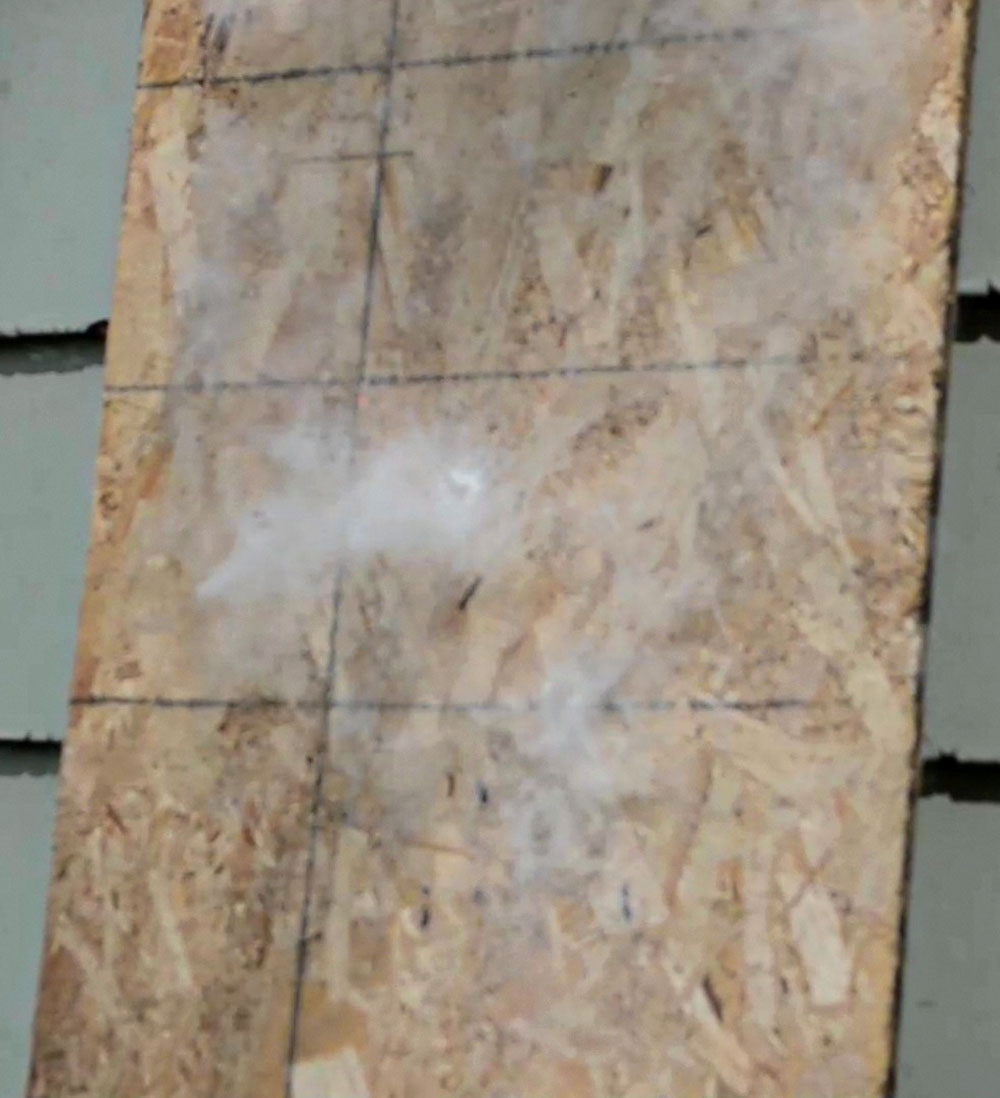
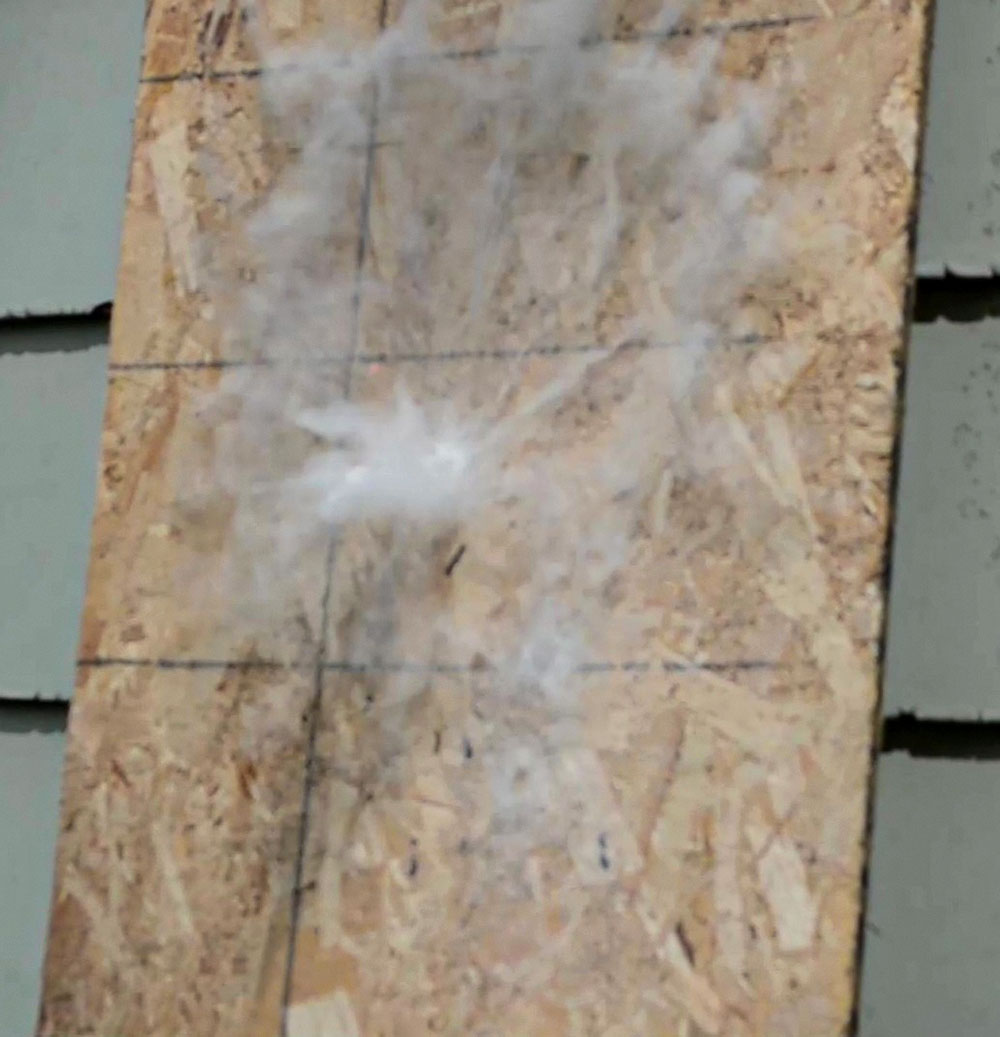

PAVA Pepper Powder
The PepperBall projectiles are loaded with PAVA pepper powder. “PAVA” stands for “pelargonic acid vanillylamide,” which is also sometimes referred to as “nonivamide.” It’s a naturally occurring capsaicinoid found in chili peppers. However, it’s also commonly produced synthetically.
In addition to being used in various pepper spray products, it’s found in seasonings and spice blends.
While neither my friend nor I volunteered to be hit by a PepperBall to gauge the effects of the PAVA powder, we’re confident that being exposed to it at close range would be similar to being nailed with pepper spray … resulting in quite a bit of pain and misery for a time.
There are two PAVA projectile options. The standard “Live SD” projectiles that come with the launchers have a 2 percent PAVA mixture, while the “Live-X” projectiles have a 5 percent PAVA mixture.
Keep in mind that the MOBILE unit is also available with only practice rounds for users who live in restrictive states, such as California, Massachusetts and New York.
Backyard Practice
If you don’t have easy access to an open area in which you can set up some targets to practice with these products, here’s a DIY solution that’s suitable for just about anywhere:
Hang a comforter from a clothesline. You can also use a thin blanket or sheets, but it might be wise to double them up. Leave the comforter or sheets loose at the bottom.
A version of this article first appeared in the September 2021 print issue of American Outdoor Guide.

